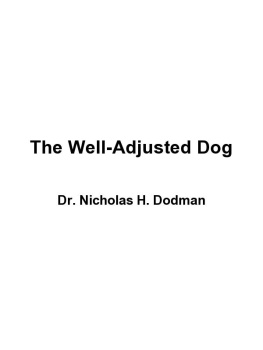Copyright 2008 by Dr. Nicholas H. Dodman
All rights reserved
For information about permissions to reproduce selections
from this book, write to Permissions, Houghton Mifflin
Company, 215 Park Avenue South, New York, New York 10003.
www.houghtonmifflinbooks.com
Library of Congress Cataloging-in-Publication Data
Dodman, Nicholas H.
The well-adjusted dog : Dr. Dodman's seven steps to lifelong
health and happiness for your best friend / Nicholas H. Dodman.
p. cm.
Includes index.
ISBN 978-0-618-83378-8
1. Dogs. 2. Dogs Health. I. Title.
SF 427. D 544 2008
636.7'0887 dc22 2007045894
All illustrations by Beth Mellor
Photo on is reprinted courtesy of Elite Pet-Havens
Book design by Joyce Weston
Printed in the United States of America
MP 10 9 8 7 6 5 4 3 2 1
AUTHOR'S NOTE: In an effort to protect the innocent, the names of some of the dogs in this treatise have been changed. That said, all the cases discussed, or employed as examples, are dogs I have known or treated as clinical patients. They either did or still do exist, and the tales about them are true.
THIS BOOK PRESENTS THE RESEARCH AND IDEAS OF ITS AUTHOR. IF A READER REQUIRES PERSONAL ADVICE, HE/SHE SHOULD CONSULT A PROFESSIONAL. THE AUTHOR AND PUBLISHER DISCLAIM LIABILITY FOR ANY ADVERSE EFFECTS RESULTING DIRECTLY OR INDIRECTLY FROM INFORMATION CONTAINED IN THIS BOOK.
To my familymy wife, Linda, and my children,
Stevie, Victoria, Keisha, and Daniel
and to dogs everywhere
A Note to the Reader
Gender-conscious readers will note that throughout The Well-Adjusted Dog, I refer to our canine companions as "he." Please accept my use of the male pronoun in the spirit it is intendedas a nonspecific term and not an indication of any gender bias on my part. On the contrary, I have equal affection for both male and female dogs.
Introduction
There is no faith which has never yet been broken, except
that of a truly faithful dog.
Konrad Z. Lorenz
While making small talk with a few friends at a cocktail party, a man mentions that his dog has started "having accidents" on the rug when the man is away from home. This behavior, he adds, is causing him a great deal of distress, not to mention wrecking his formerly close relationship with his dog. One of his friends, trying to be helpful, says, "I've heard the best thing to do in that situation is to push their nose in it to show them it's wrong." (The dog would have no clue what was going on if the man did this and would probably consider his owner's behavior, well, strange.) Another individual chimes in: "You should punish him for that. After all, he knows he's done something bad. I would rap him on the nose with a rolled-up newspaper when you get home."(Punishment after the fact is a total waste of time and will make your dog mistrust you.) A third person believes that he has the best solution to his friend's predicament. "Put him in a crate while you're away," he says with conviction. "That worked for our dog." (What this person does not realize is that a dog that has accidents only in his owner's absence probably has separation anxiety; such a dog may seriously injure himself in attempts to break out of a crate when his owner is away.) As part of the continuing barrage of advice, a fourth individual suggests that the man put ammonia on the spot where the dog has urinated, to obliterate the urine smell and thus prevent the dog from returning to that spot. (This will only make matters worse; ammonia smells like urine and the dog will often mark over it.)
It never ceases to amaze me how much misinformation exists on the care and management of pets. I find it remarkable that the same people who consider themselves experts in the field of animal behavior would never think of offering advice on a medical question, like what antibiotic to use for a dog with a bladder infection or what problems may result if a dog's cholesterol level is too high. If you're a nonspecialist, the proper answer to these and other such questions is usually, "I don't know" (the three words a wise person uses most often). A reasonable alternative is, "Why don't you check with your vet and see if she can help or refer you to a specialist?" Even veterinarians don't venture advice unless they know it to be sound. I am reminded of a quote that appears on the first page of each issue of one of the British medical journals: "I would have everie man write what he knowes and no more" (Montaigne). I've always adopted this as my personal maximwhether writing or speaking.
The man at the cocktail party might also have turned to the Internet for advice about his dog's behavior. The problem is, much of what is found on the Internet is written by guys like the ones at the cocktail party. There is more information out there than you can shake a stick at, but it's hard to know what or whom to believe. With the World Wide Web, it is definitely a case of user beware. You may read about the efficacy of Bach flower essences and other "natural" antianxiety medications. You might find yourself musing about aromatherapy, touch therapy, and dog yoga, or you might even be taken in by an "animal communicator." Then again, you might wind up at the sites of hard-line dog trainers who will tell you that you have to be "alpha" and advocate such supposedly dominance-establishing techniques as rolling, pinning, and chain jerking.
So how do you know what's right and what's not among all the information out there? First, assess the source. If the author-adviser is certified by the Animal Behavior Society or the American College of Veterinary Behaviorists, you can trust that you are receiving an educated opinion. If the author is a dog owner turned dog trainer/behaviorist, you should be more skeptical. Next, make sure you are comfortable with the advice being offered and fully understand what resolution of the problem entails. If what is being said makes sense from a logical and practical standpoint, then you are probably on the right track. Finally, avoid any training program that involves physical punishment as a means to an end. Know that "a correction" in trainer lingo is a euphemism for punishment or warning of imminent punishment. Also know that chain jerking and electric shock treatment are inhumane and outmoded training methods. In my opinion, the only time the word "jerk" should be used in dog training is when referring to those who employ this technique.
One of my goals in writing this book is to dispel some of the myths and misconceptions about how to look after dogs, how to manage them, and how to train them to be well-adjusted, good canine citizens. One of the most prominent falsehoods is that once a puppy is housetrained and has graduated from a puppy-training class, a dog owner's work is done. Nothing could be further from the truth. While it is true that the first few months of a pup's lifeeven the first yearare formative times, plenty of consideration must be given and actions taken throughout a dog's life if optimal welfare is to be sustained. Caring for an adult dog does not simply involve feeding him and taking him for short walks around the block for elimination purposes. A high quality of life for dogs, as for humans, requires more than basic sustenance. Providing a healthy lifestyle for a dog and attending to his physical and psychological needs are lifelong commitments. Training should be thought of as an ongoing process of continuing education extending long past puppy "kindergarten." Dogs can and do learn well into old age and should not be denied the opportunity to expand their communication skills and repertoire of responses throughout the course of their lives.
A dog's lifestyle, daily routine, and interactions will, to a large extent, determine how he feels and how he behaves. When behavior is out of kilter, it is important to address the bigger picture rather than try to suppress the symptoms of an underlying problem. The uninformed approach tends to be, "You tell me what your dog is doing wrong and I'll show you how to stop him from doing that." A behaviorist, however, asks why there is a problem, and has a broad, long-term approach to resolving it. I will share with you the latter approach: treatment of the whole dog within the context of his environment, not just the symptom or symptoms of the problem. Furthermore, the information I will provide is based on scientific studies and my thirty-seven years of clinical experience: it is not just my personal opinion (though I am not shy to offer one based on the facts). Objective assessment of outcomes is the best way to find out if treatments actually work in the short and long term, and studies of this sort are what scientists do. It is not sufficient follow-up to ask an owner how a dog is doing and if they say fine, chalk it up as a success. Most people, trying hard to please (and justifying their expenditure of money, time, and effort), will volunteer that their dog is doing better even when he's not. Or owners may be so pleased with minor improvement in one area of behavior modification that they report in superlatives, laying their praise on inordinately thick. Some owners fail to call back. That might mean the problem has been resolved, but it could mean exactly the opposite. Optimistic trainers think no news is good news, but it could be that the dog's behavior is unchanged or has deteriorated. Owners may have given up asking for further advice because nothing is working out, or they may have even had the dog "put to sleep." It's impossible to tell what's what without proper organized studies in which the behavior is rated as objectively as possible. Behaviorists take this approach, and share their findings with their colleagues in print. This book seeks to relay to dog owners all that has been learned from such empirical studies.
Next page








